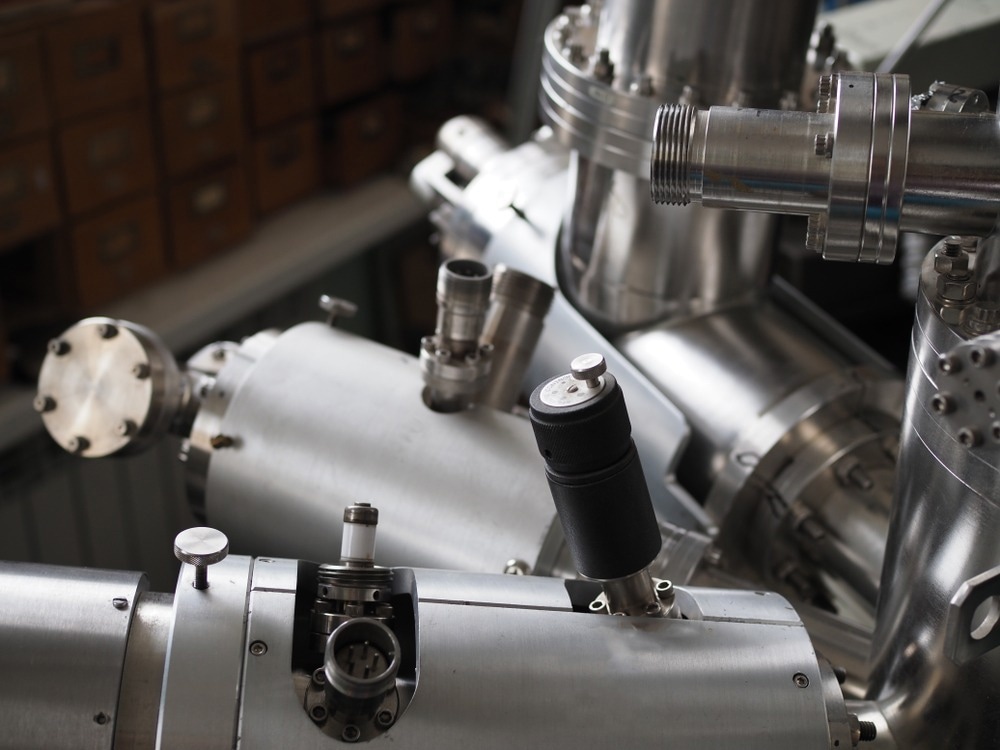Spray ionization using electroactive polymers (EAP) for ambient ionization mass spectrometry (MS) has been proposed as an efficient technique for rapidly analyzing small samples with high accuracy. The experimental details of the research headed by Professor Jennifer Irvin’s group at the Materials Science, Engineering and Commercialization Program, Texas State University, is published in the Journal of the American Society for Mass Spectrometry.

Study: Electroactive Polymer-Based Spray Ionization for Direct Mass Spectrometric Analysis. Image Credit: White_Fox/Shutterstock.com
What is Mass Spectrometry (MS)?
Mass spectrometry detects constituent molecule mass within a sample to identify its make-up. The mass is typically separated by time of flight analysis, where particle masses take different times to travel and fall across a chamber due to the gravitational force.
In mass spectrometric analysis, the introduction of ambient MS has significantly improved the experimental procedure by eliminating the processes involved in sample preparation.
In addition to demanding sample preparation and data interpretation, most traditional MS used in structural elucidation, imaging, proteomics, and peptide detection heavily rely on large, costly machines. On the other hand, ambient MS requires little to no sample pretreatment to extract the desired molecules.
Advantages of Ambient Mass Spectrometry
The sample is placed outside a mass spectrometer for an ambient MS measurement.
This set-up provides flexibility in sample studies, particularly for surface examinations. The stability and intensity of the analyte ion signals are greatly influenced by the geometry of an ambient ionization sample, namely the spatial arrangement of the electrospray source, sample surface, and mass spectrometer input.
The physicochemical properties of the many different surface types that have been proposed can affect the mass spectrometric efficiency. These include limit of detection (LOD), sensitivity, and limit of quantification (LOQ).
Paper spray ionization (PSI) MS, one of the ambient ionization MS variations, was designed to address the two most recent demands in MS: miniaturization of MS devices and direct sampling.
Improvements to Ambient Mass Spectrometry
The use of additional sophisticated substrate surfaces and the alteration of ordinary paper surfaces have been adapted to improve the application of the PSI technique.
To initiate spray production between the paper surface and MS intake, ionization voltage must be carried via a conductive substrate in PSI MS.
Typically, a high voltage source is attached directly to that substrate, but it is also possible to apply a high voltage by induction, for example, using electrostatic spray (EAS) ionization.
It was recently shown that paper coated with conductive polymers displayed a stronger intensity sensitivity for several forensically important analytes than uncoated paper.
Spray Ionization Using Electroactive Polymers (EAP)
Professor Irvin’s team researched different conductive surfaces for ambient ionization MS.
The EAP coating effects, such as poly(3-hexylthiophene) (P3HT), poly(3,4-ethylenedioxythiophene) (PEDOT), poly[3,4-(2-dodecylethylenedioxy)-thiophene] on indium tin oxide (ITO) coated glass, were studied.
As described in the journal article, the coatings used for conductive surfaces for ambient ionization MS were procured from commercial sources.
Chemical oxidative polymerization and electropolymerization were used to prepare the coated samples. Experimental protocols, such as an oxidized polymer mat for filtering and cleaning with methanol, helped produce a free-standing conductive platform for ionization.
A commercial dual-cell linear ion trap mass spectrometer with a unique ionization source was used for all MS investigations. Spray solvent was prepared to combine methanol and water at specific concentrations.
As alternatives to paper, various conductive substrates with various hydrophobicities were researched; absolute abundances were utilized to compare the absolute performance of the various substrates.
The Future of Fast and Accurate Mass Spectrometry Analysis
EAP and paper spray ionization helped study peptides and small-molecule medicines in 0.1% formic acid in methanol/water and synthetic biological fluid matrices.
As little as 0.1 L of the solution was needed for each analysis, and the resulting sprays were reliable and consistent.
Bradykinin, cannabinol, and cannabidiol were produced in pure solvents and used to test the sensitivity, limit of detection (LOD), and limit of quantification (LOQ) in artificial urine and saliva.
For analytes prepared in methanol/water, the limits of detection and quantitation for EAP spray ionization were improved by 1−2 orders of magnitude relative to PSI.
Similar results were observed for PSI for analytes prepared in artificial saliva and urine.
Based on EAP, the spray ionization method developed by Prof. Irvin and his team offers the potential for fast and highly accurate MS analysis with small sample sizes and MS apparatus minimization.
References
Xu Wang, David D. Hebert, Damilola O. Runsewe, Gabriel E. Pohlman, William D. Hoffmann, and Jennifer A. Irvin. (2022) Electroactive Polymer-Based Spray Ionization for Direct Mass Spectrometric Analysis. Journal of the American Society for Mass Spectrometry. https://pubs.acs.org/doi/10.1021/jasms.2c00148
Disclaimer: The views expressed here are those of the author expressed in their private capacity and do not necessarily represent the views of AZoM.com Limited T/A AZoNetwork the owner and operator of this website. This disclaimer forms part of the Terms and conditions of use of this website.